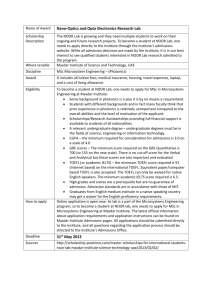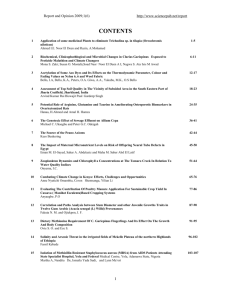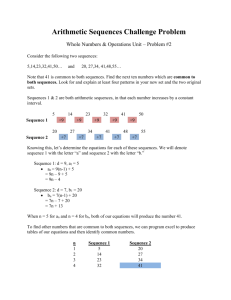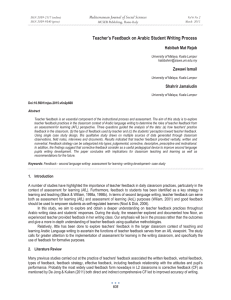Word
advertisement
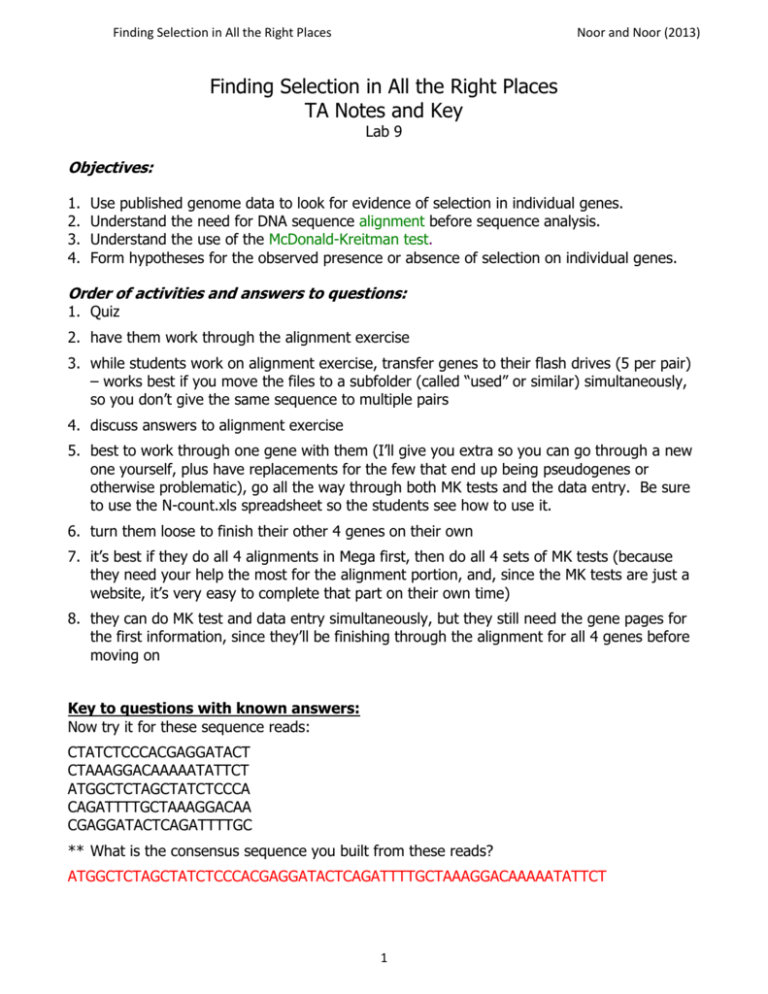
Finding Selection in All the Right Places Noor and Noor (2013) Finding Selection in All the Right Places TA Notes and Key Lab 9 Objectives: 1. 2. 3. 4. Use published genome data to look for evidence of selection in individual genes. Understand the need for DNA sequence alignment before sequence analysis. Understand the use of the McDonald-Kreitman test. Form hypotheses for the observed presence or absence of selection on individual genes. Order of activities and answers to questions: 1. Quiz 2. have them work through the alignment exercise 3. while students work on alignment exercise, transfer genes to their flash drives (5 per pair) – works best if you move the files to a subfolder (called “used” or similar) simultaneously, so you don’t give the same sequence to multiple pairs 4. discuss answers to alignment exercise 5. best to work through one gene with them (I’ll give you extra so you can go through a new one yourself, plus have replacements for the few that end up being pseudogenes or otherwise problematic), go all the way through both MK tests and the data entry. Be sure to use the N-count.xls spreadsheet so the students see how to use it. 6. turn them loose to finish their other 4 genes on their own 7. it’s best if they do all 4 alignments in Mega first, then do all 4 sets of MK tests (because they need your help the most for the alignment portion, and, since the MK tests are just a website, it’s very easy to complete that part on their own time) 8. they can do MK test and data entry simultaneously, but they still need the gene pages for the first information, since they’ll be finishing through the alignment for all 4 genes before moving on Key to questions with known answers: Now try it for these sequence reads: CTATCTCCCACGAGGATACT CTAAAGGACAAAAATATTCT ATGGCTCTAGCTATCTCCCA CAGATTTTGCTAAAGGACAA CGAGGATACTCAGATTTTGC ** What is the consensus sequence you built from these reads? ATGGCTCTAGCTATCTCCCACGAGGATACTCAGATTTTGCTAAAGGACAAAAATATTCT 1 Finding Selection in All the Right Places Noor and Noor (2013) ** Consider the 5 sequences below. How many polymorphic sites (base pair positions that are not the same nucleotide for all 5 samples) are there? Hint: make a mark underneath each polymorphic site and then count your marks. A A A A A A A T A A A G A A A A A A A A A G A A A G T G G G G C G G G A A A A A G A G G G T C T T T C T C C C A A A A A A T A A A C T C C G T G T T T A G A A A T A T T T T A T T T G A G G G G T G G G A T A A A A C A A A A T A A A T G T T T T C T T T C A C G C T T T G T GCAT GCAT A AATTCTGCAT GCAT This can be easier to see if each nucleotide is highlighted with a different color (which you can do with the colored highlighters on your lab bench). A A A A A AA AG TA AA AA ** =34 A A A A A A GG GT C A GG A GG A GG *** A A A A A GTC A CT GTC GTC GTC *** A A A A A AC T A TTGGAAAT TC T GCAT TT GGAAA T TCTGCA T AC T A TTGGAAAT TC T GCAT AC T A TTGGAAAT TGGA AATTCTGCAT AGT A TTGGAAAT TC T GCAT ************************** 2 Finding Selection in All the Right Places Noor and Noor (2013) ** Look at the color-coded sequences more carefully, paying close attention to the patterns made by the colors. Pay particular attention to the sequences that are different lengths than the others. Do you notice anything about the color pattern? Could you shift the sequences in any way to make the pattern better? What do you think caused these changes? If sequence 2 was shifted to the right 4 bases and either 7 bases were removed from the center of sequence 4 or all the other sequences were shifted over 7 bases, then the patterns would match up much better. The change in sequence 2 was probably the result of a deletion mutation and the change in sequence 4 was probably the result of an insertion mutation. A A A A A A A T A A A G A A A A A A A A A G A A A G T G G G G C G G G A A A A A G A G G G T C T T T C T C C C A A A A A A T A A A C T C C G T G T T T A G A A A T A T T T T A T T T G A G G G G T G G G A T A A A A C A A A A T A A A T G T T T T C T T T C A C G C T T T G T GCAT GCAT A AATTCTGCAT GCAT ** Redraw the 5 sequences in the table below making the changes you suggested above. Put one nucleotide in each box of the table. Don’t worry if you don’t fill the table completely, at this point there’s more than one way to answer the question. A A A A A A A T A A * A A A A * A A A A * A A A A * G G G G * G G G G G A A A A A G G G G G T T T T T C C C C C A A A A A A A A A A CT CT CT CT GT * A A A A A T T T T T T T T T T G G G G G G G G G G A A A A A A A A A A A A A A A T T T T T T T T T T G * G * A * A * A * T * T * C C C C C T T T T T G G G G G C C C C C A A A A A T T T T T 13 Also OK if they just deleted the insertion in sequence 4, but then point out that they lost that polymorphism and ask which way (deleting insertion or adding spaces in other sequences) gives a more accurate representation of the differences between the sequences. ** Highlight the different bases in the table above different colors using the highlighters provided. It doesn’t matter which color you use for which nucleotide. How many polymorphic sites are there now? 13 ** Of the two counts of polymorphic sites that you made, which gives the more realistic representation of the differences between these sequences? The second is probably more accurate because the chance that the overall pattern would be recreated by independent base changes is much lower than the chance of the one insertion and one deletion. ● Familiarize yourself with the Mega window. ** What do the asterices along the top row indicate? 3 Finding Selection in All the Right Places Noor and Noor (2013) Base positions in which all the strains have the same base (conserved bases) ** What does a deletion in only one strain look like? A deletion in only one strain will be a “–“ in a white space while the other strains have nucleotides in colored spaces. ** How about an insertion in only one strain? An insertion in only one strain will be a nucleotide in that one strain while all the other strains have dashes in white spaces. ** Arginine is one of the amino acids with the most codons encoding it, while tryptophan is one of the amino acids with the least. Using a codon table, determine how many single base pair mutations to the arginine codon CGA (written in RNA, but the answer would be the same for mutations to the DNA, right?) would be synonymous and how many would be nonsynonymous. Do the same for the tryptophan codon UGG. So what can you say about the possible number of synonymous and nonsynonymous substitutions for all codons? Arginine: 4 synonymous, 5 nonsynonymous Tryptophan: 0 synonymous, 9 nonsynonymous There will always be more possible nonsynonymous than synonymous substitution mutations ** There are three possible relationships that could be seen in the Contingency Table (think about comparing the nonsynonymous/synonymous ratios of between and within species). What are they and what does each one mean? Ratios equal between and within species and more synonymous than nonsynonymous -> exactly what is predicted by the neutral theory Ratios not equal, between species > within species -> evidence that positive selection is driving the between species differences Ratios not equal, between species < within species -> either purifying selection so the strains have low frequency within species polymorphisms that were never fixed between species, or balancing selection is maintaining polymorphism within one or both species 4 Finding Selection in All the Right Places Noor and Noor (2013) Alternate McDonald-Kreitman Test instructions, in case http://mkt.uab.es is down NOTE: requires Windows and the free software DnaSP (http://www.ub.edu/dnasp/) ● start the DnaSP program by clicking on the icon in the Taskbar. ● Open your aligned .fas file by clicking the Open button and navigating to your file. DnaSP should see it, but if it doesn’t, make sure that “Files of type” at the bottom is set to “All Data Files” or “FASTA files.” ● You can click Close on the Data Information window that pops up. ● Go to Analysis -> McDonald and Kreitman Test and a popup will appear asking if you want to define a protein coding region – click Yes. ● You can either click OK for the default values that appear (because the default is the entire sequence with the reading frame starting with the first base, which is true of your data) or you can subtract 3 from the ending site because DnaSP does not consider STOP codons to be coding sequence. If you don’t subtract the last 3 bases, then DnaSP will ask if you want it to do that for you. 5 Finding Selection in All the Right Places Noor and Noor (2013) OR ● A popup will ask if you want to define more coding regions – click No. ● If you didn’t subtract 3 from the ending site, you will now be asked if you want DnaSP to assign the STOP codon as a noncoding position, click Yes. 3- Define sequence sets. For the following instructions, the number in parentheses refers to the red number in the image. ● A popup will then prompt you to define sequence sets (sequences for each species) – click Yes. ● Now you need to know which strains belonged to each species. Select all of the D. pseudoobscura strains and click on >> (1). ● Click the “Add new Sequence Set” button (2) and name that set Dpseudoobscura. 6 Finding Selection in All the Right Places 1 Noor and Noor (2013) 3 2 4 5 ● Then select all the D. miranda strains and click >> (3). ● Click “Add new Sequence Set” (4) again, and name that set Dmiranda. ● Click the “Update All Entries” button (5). Make sure everything in the popup looks right, then click OK. 7 Finding Selection in All the Right Places Noor and Noor (2013) 4- Record your McDonald-Kreitman results. The most important information is at the bottom of the output screen. An example is shown below. The McDonald and Kreitman Table summarizes the values used in the McDonald-Kreitman test. Fixed differences between species are sites at which all sequences in one species contain nucleotide variants that are not in the second species. Polymorphic sites are those that are variable within a single species. Use the results of the Fisher’s exact test to determine whether the MK result is significant (DnaSP will tell you explicitly if it is not significant, it uses P<0.1 as the requirement for significance). 8

